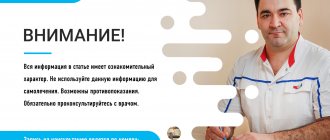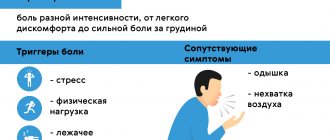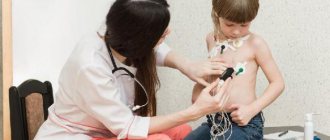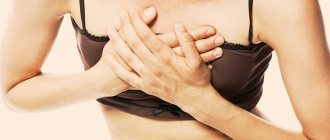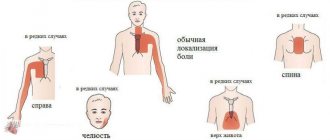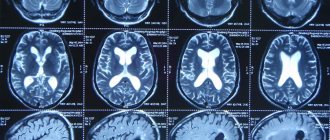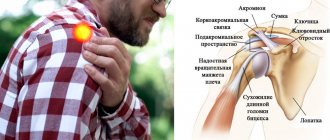What parents should pay attention to
As mentioned just above, reasons for concern when a child has pain in the heart area may not only be cardiac diseases. Pay attention to how often your child's pain occurs and how long it lasts. Observe whether there is shortness of breath after vigorous physical activity.
It is advisable to take the pulse at the moment when the child complains of chest pain, and also ask if anything else is bothering you.
If you notice any unusual changes in your baby’s behavior, be sure to inform the doctor at your appointment. The child may not immediately contact the doctor, so it is worth finding out in advance what is bothering your child.
Causes of heart attack in teenagers
Heart attacks in minors are a rare disease. In most cases, a teenager becomes a victim of a heart attack for the following reasons:
- An underlying congenital heart disease that has gone undetected.
- Hypertrophic cardiomyopathy (enlarged heart muscle cells), an inherited disease.
- Kawasaki disease (inflammation of blood vessels), which is also inherited.
- Pericarditis (inflammation or irritation and swelling surrounding the heart), myocarditis (inflammation of the heart muscle).
- Excess weight, which leads to type II diabetes and increased blood pressure and “bad” cholesterol levels.
- Smoking, a major risk factor for heart attacks.
- Congenital heart abnormality (problems in the structure of the heart).
Causes of pain in the heart area
Among non-cardiac reasons:
- diseases of the spine;
- diseases of the gastrointestinal tract - the child has pain in the heart area due to irradiation of pain from the stomach;
- vegetative-vascular dystonia;
- emotional experiences;
- neurological disorders, etc.
If we talk about diseases of the heart and blood vessels, the reasons may be:
- myocarditis;
- endocarditis;
- pericarditis;
- rheumatism;
- aortic aneurysm, etc.
There is no need to panic - the best thing you can do is to go to a specialist as soon as possible.
Heart pain in children
General information
Pain in the heart area in children is one of the common reasons for visiting a doctor. It is important for the doctor to clarify their localization, time of appearance, constancy or sporadicness of painful phenomena, intensity, distribution, connection of pain with physical or psycho-emotional stress and other factors. It is important to identify the factors that cause and relieve pain. Painful sensations in the heart in children are mainly stabbing in nature (86.9%), localized in the apex of the heart (96.1%), provoked by a stressful situation (79.6), do not radiate, are not associated with physical activity, decrease or disappear when the child’s attention is diverted, as well as after taking sedatives.
Causes of heart pain in children
Heart pain in children most often has a functional nature and, as a rule, may not be associated with heart pathology. Cardialgia in children of early school age is usually a manifestation of the so-called growth disease, when the intensive growth of the heart muscle outstrips the growth of the vessels supplying blood to this organ.
Such pain usually occurs in asthenic, emotional, active children against the background of physical activity , fast walking or running. Once the child stops, rests, calms down, the pain goes away. Such cardialgia is usually of a stabbing nature and can be repeated not once, but periodically over several months. Heart pain in adolescence is usually associated with a violation of the autonomic regulation of the heart, that is, it is a manifestation of vegetative-vascular dystonia . Pain in the heart during VSD is also more often of a stabbing nature, localized in the left half of the chest, the left axillary region, and can occur in a calm state. Very often, in a child, the pathology of other organs and systems simulates pain in the heart. In the first place is the pathology of the spine (scoliosis, early osteochondrosis). In second place is the pathology of the nervous system (neuroses and others) And, finally, the pathology of the gastrointestinal tract:
- biliary dyskinesia;
- cholecystocholangitis.
Typical for children is the inability to correctly localize the source of pain. So, for example, with abdominal pain, a small child may point to the chest, the area of the heart. Pain in neuroses is usually localized in the region of the heart itself (at the apex), can be stabbing, aching in nature, and is accompanied by a number of emotional manifestations and motor restlessness. Sharp pain with inspiration, coughing , or other respiratory movements usually points to the pleura and pericardial region or mediastinum as a possible source of pain, although pain in the chest wall is also likely to be influenced by respiratory movements. Similarly, pain that regularly occurs when walking quickly and disappears within a few minutes after stopping is still considered a typical sign of angina, although similar phenomena may occur in patients with skeletal disorders and injuries. Particular attention should be paid if heart pain in a child occurs against the background of an acute current illness (ARVI, influenza), which may indicate the development of viral myocarditis . And also if pain occurs 2-3 weeks after suffering from a sore throat or scarlet fever. After such a time after streptococcal infection, rheumatism begins. With such serious complications as myocarditis and rheumatism, in addition to pain in the heart, other complaints are also disturbing:
- signs of intoxication;
- malaise;
- joint pain;
- interruptions in the heart.
In such a situation, you should immediately consult a doctor. Cardialgia associated with heart damage in children is observed with:
- abnormal coronary circulation;
- pericarditis;
- with a sharp expansion of the heart or great vessels.
With an anomalous coronary origin of the left coronary artery from the pulmonary artery (Blandt-White-Garland syndrome), squeezing, squeezing pain, localized behind the sternum, can radiate to the neck, jaw, and shoulders. Postcardiotomy syndrome : dull pain behind the sternum, fever, arthralgia appear several weeks after surgery, accompanied by opening of the heart cavity, in 30% of operated children. Characterized by expansion of the borders of the heart, increased ESR, increased antibodies to the heart muscle in the blood, which is considered as a hyperergic reaction of the body to damage to the cells of the heart muscle.
Other causes of pain
With pericarditis, there can be two types of heart pain. Pleural pain associated with respiratory movements and aggravated by coughing and (or) deep inspiration is caused by the pleuritic component of infectious pleuropericarditis. The second type of pericardial pain is a pressing retrosternal pain simulating myocardial infarction or angina.
Pain is caused by inflammation of the sensitive internal parietal surface of the pericardium or irritation of the afferent nerve fibers of the heart lying in the periadventitial layer of the superficial coronary arteries. Pain caused by pericarditis is usually expressed as a feeling of pressure. It occurs with infectious or rheumatic pericarditis . The intensity of the pain varies from slight to severe, the pain intensifies with movement and deep inhalation. When dry pericarditis transitions to exudative, pain stops, and at the same time, muffled heart sounds, venous congestion, and a triangular mediastinal shadow appear.
Dull, prolonged pain in the heart area, sometimes with a strong tingling sensation, as well as pain radiating to the left arm and shoulder, as with angina pectoris, can be caused by myocarditis or pericarditis due to acute enlargement of the heart. If the pain is combined with a friction noise synchronous with heartbeats, visible venous congestion in the veins of the neck and hepatomegaly, one should think about pericarditis (characteristic of the x-ray configuration of the heart). It is also a mistake to believe that heart pain in a child is a manifestation of a heart defect. Congenital heart defects often have other clinical signs. If pain in the heart occurs in an apparently healthy child, but is repeated repeatedly, and the child focuses on it, then there is a need to visit a pediatrician or pediatric cardiologist. It is possible that after examining the heart (ECG and ultrasound), consultations with other specialists will be needed: a neurologist, an orthopedist, a gastroenterologist. They will be able to choose the optimal solution that will help the child recover as soon as possible.
When should you see a doctor if your child has a stabbing sensation in the heart area?
If the episode is isolated and the child does not notice any unusual phenomena accompanying it, then it is still worth making an appointment with a specialist.
If pain in the heart area occurs systematically, do not ignore it under any circumstances, but do not panic either - your emotional stress should not be passed on to the child.
Recurring episodes require contacting a doctor. It is especially important to consult a doctor as soon as possible if you have symptoms such as fever, fainting, or weakness.
If you have pain in the heart area, you should first contact your pediatrician. The doctor will perform an examination, listen to the heart and then (if necessary) give a referral to a highly specialized doctor - a pediatric cardiologist. You will not have to waste precious time in queues if you contact JSC “Medicine” (clinic of Academician Roitberg). Diagnostic measures are carried out promptly. Treatment will most likely be prescribed on the day of treatment (it all depends on the diagnosis and its form).
Pediatrician appointment prices:
| TYPES OF MEDICAL SERVICES | Cost, rub. |
| Examination of a child by a pediatrician to obtain a certificate + certificate | 1950 |
| Visit of a pediatrician, consultation at home (Moscow) | 5400 |
| Consultation with a pediatrician at home for the second child | 1950 |
| Patronage for a newborn / gymnastics and swimming at home (1 session, pediatrician Kapina A.V.) | 6300 |
How to quickly help your child
If pain does not go away within a short time, parents do not need to panic, because with their behavior they can frighten the baby even more. You need to provide the child with enough fresh air and call an ambulance.
Before the doctors arrive, a tablet of glycine, valerian or validol is allowed if the child is over 5 years old. The child does not always make contact with an unfamiliar doctor, so before the doctor arrives, you should try to find out what type of pain the child is experiencing, how much it hurts, and the exact location of the pain. You need to ask in a calm, confident voice, and don’t get nervous if the baby can’t answer intelligibly.
Causes of pain
If you take all the clinical cases and add a little theoretical knowledge, you can find out why the child has an unpleasant sensation in the heart area.
- Functional pain. Most often observed in primary schoolchildren and adolescents. At this time, the final formation and growth of organs occurs, and hormonal fluctuations occur.
- In adolescence, the symptom appears against the background of vegetative-vascular dystonia, due to pressure fluctuations.
- Cardialgia develops against the background of a viral or bacterial infection. With such diseases, the load on the heart increases (pulse increases, temperature rises). But in this case, I cannot exclude such a complication as myocarditis.
- I often met in practice children who complained of pain in the heart, but in fact they were diagnosed with pathologies of the spine, problems with digestion, and bile ducts. And the sensations on the left side of the chest were simply irradiation from the main source.
- The left chest may hurt after an injury or bruise.
- Finally, unpleasant sensations can be associated directly with diseases of the heart muscle, pericardium and blood vessels. In this case, a complete examination of the child’s heart is necessary (taking a dynamic cardiogram or monitoring it, echocardiography, general blood tests and biochemistry).
Case from practice
Parents came for a consultation with a 13-year-old child who complained of stabbing pain in the heart area.
Appeared several months ago; previously I was ill only with colds. When collecting anamnesis, it became clear that an unpleasant sensation appears after eating, especially when eating fatty and heavy foods. It is accompanied by symptoms such as nausea and sometimes vomiting. No abnormalities were found on the ECG. A consultation with a gastroenterologist and an ultrasound of the liver showed a violation of the outflow of bile from the bladder and its inflammation. The boy was referred to a gastroenterologist.
Expert advice
If a child begins to complain of heart pain, I usually advise calming down and trying to figure out what it might be related to. First you need to put him on the bed, then sit him down, ask him to bend over, and take a deep breath. Cardiac pathology usually does not depend on changes in body position. If a child talks about increased pain when bending over, most likely we are talking about a pinched nerve root in the spine due to its structural disorders. Pain when breathing can occur with inflammatory pathology of the respiratory system. But when a child often has heart pain, the discomfort is burning or pressing, what to do in this case? It is important not to delay diagnosis and treatment. For this purpose, you should contact your pediatrician. After the necessary examinations (ECG, X-ray, EchoCG), it will be possible to determine the causes of the symptoms and take measures. You should consult a doctor immediately if heart pain in children is accompanied by:
- high temperature;
- cough, shortness of breath;
- severe weakness;
- lack of appetite;
- nausea and vomiting;
- constipation or diarrhea;
- arrhythmia;
- blue or pale skin;
- increase or decrease in pressure;
- deterioration of the condition after physical activity.
Dear parents, how many of you have encountered similar problems when a child complained of heart pain, and how were they solved in practice? Share your experience - it may help others.
How often does your heart hurt?
Nature of pain and pathology
It is important to consider in more detail the main causes of heart pain, which are associated with pathological processes in the body. The strength and severity of sensations, the time of its appearance and the provoking factor play an important role in diagnosis.
Stitching pain usually occurs in the following cases:
- pressure changes due to dystonia;
- neurosis;
- penetration of air into the pleural cavity of the left lung;
- pericarditis;
- rachiocampsis;
- heart disease, myocardial dystrophy, coronary blood flow disturbance.
Pressing pain in the left chest often accompanies severe abnormalities and may be a sign of:
- pericarditis;
- myocardial ischemia;
- aneurysms;
- congenital abnormalities in the structure of valves and coronary vessels.
It is important to understand that children who complain of heart pain are not always just trying to attract the attention of their parents. It cannot be ruled out that the child is telling the truth. In this case, it is best to play it safe and undergo a full examination.
Causes of VSD
The basis of the disease is a violation of the neurohumoral regulation of the autonomic nervous system, which is responsible for the stability and coherence of the activities of all internal organs and the body as a whole. This is a department of the nervous system that is not subject to the consciousness and control of the human will.
There are many causes of the disease. Among the first are hormonal disorders, including transient ones - during puberty, menopause, and pregnancy. Infectious diseases (including physical detraining after infection), foci of chronic infection (caries, sinusitis, tonsillitis), and allergies play a significant role. Psycho-emotional stress, traumatic brain injuries, a sedentary lifestyle, bad habits - smoking, alcohol, unhealthy diet - predispose to the disorder. Hereditary predisposition is important.
